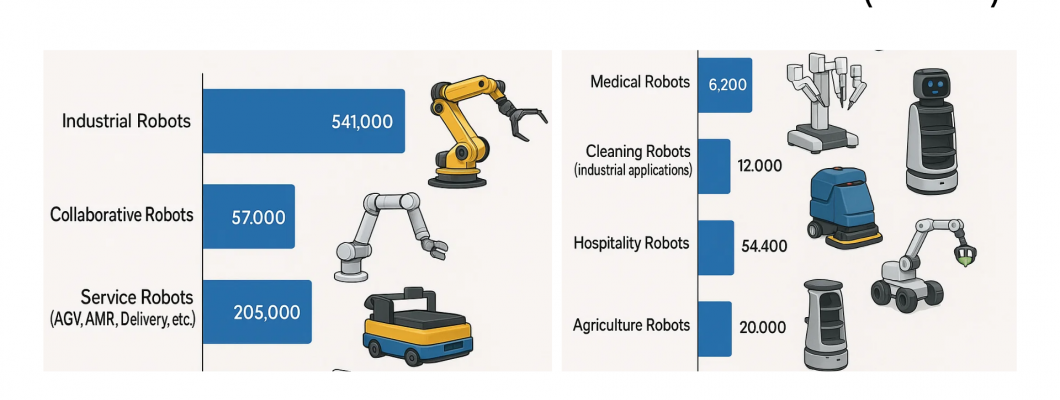
A Deep Dive into the Rise of Robotics Across Sectors
As we advance further into the Fourth Industrial Revolution, the use of robots in nearly every industry is accelerating at an unprecedented rate. The most recent sales data from 2023, visualized in a compelling infographic released by the Global Robot Marketplace, paints a vivid picture of this transformation. With over 895,000 robots deployed across industrial, commercial, and healthcare domains, the global robotics ecosystem is evolving into a pillar of the modern economy.

1. Industrial Robots Dominate the Market
Leading the way are Industrial Robots, with an astounding 541,000 units sold in 2023 alone. These machines are the powerhouses of production, found in automotive plants, electronics assembly lines, and heavy manufacturing sectors. Their capabilities range from welding, painting, and assembling to precision milling and material handling.
This segment’s dominance reflects growing investments in factory automation, particularly in Asia and Europe, where demand for scalable, consistent, and safe manufacturing practices has grown post-pandemic. Industry leaders are increasingly integrating these robots into smart factories, where AI and IoT technologies synchronize robotic tasks with supply chain logistics and predictive maintenance.
2. Collaborative Robots (Cobots) Gain Momentum
With 57,000 units deployed, Collaborative Robots often referred to as cobots are revolutionizing how humans and machines interact on the factory floor. Unlike traditional industrial robots, cobots are designed to operate safely alongside human workers without the need for protective fencing. They are especially valuable in small- and medium-sized enterprises (SMEs), which benefit from their flexible programming and minimal infrastructure requirements.
Cobots are now common in packaging, quality inspection, assembly, and even food processing. The growth of this segment signifies a shift toward hybrid work models where human creativity is augmented by robotic precision.
3. Service Robots: The Future of Logistics and Delivery
The Service Robot segment, including AGVs (Automated Guided Vehicles), AMRs (Autonomous Mobile Robots), and delivery bots, accounted for 205,000 units sold globally. These systems are increasingly found in warehouses, hospitals, airports, and retail environments.
E-commerce giants and logistics firms are embracing mobile robots to streamline warehouse operations, reduce delivery times, and optimize inventory handling. In healthcare, service robots are used to transport medicine, food, and equipment safely across departments, minimizing human contact and reducing errors.
This surge highlights the growing importance of autonomous mobility and AI-driven logistics in a world where speed and efficiency are paramount.
4. Medical Robots: Precision in Healthcare
6,200 units of Medical Robots were installed in 2023, primarily in surgical settings. These robots enhance a surgeon's ability to perform minimally invasive procedures with higher accuracy and stability. From robotic-assisted laparoscopic surgery to autonomous diagnostic tools and remote-operated systems, robotics is revolutionizing patient care.
COVID-19 accelerated the adoption of robotic solutions in healthcare, particularly for disinfection, remote monitoring, and handling infectious waste. As healthcare systems around the world face increased pressure, medical robots are seen not as a luxury but as a necessity.
5. Cleaning Robots in Industrial Environments
Industrial and commercial cleaning saw the deployment of 12,000 Cleaning Robots. These machines are typically autonomous and equipped with advanced sensors to navigate large spaces such as malls, factories, and airports.
With hygiene standards reaching new heights, especially in public spaces and production facilities, automated cleaning robots offer consistency, 24/7 availability, and data-driven reporting on cleanliness. This technology is reducing the burden on human cleaning staff and ensuring compliance with evolving regulations.
6. Hospitality Robots Serve the New Experience Economy
54,400 units of Hospitality Robots were introduced in 2023, marking a significant shift in customer service experiences. These robots are now commonly found in hotels, restaurants, and event venues—serving food, guiding guests, and even checking in visitors at smart reception desks.
Driven by labor shortages and increasing customer expectations, hospitality robots provide consistent service, entertainment, and operational insights. Their friendly appearance and interactive features make them popular in Asia, particularly in Japan and South Korea, where robot waiters and hotel concierges are fast becoming the norm.
7. Agricultural Robots: Feeding the Future
Agricultural automation is catching up quickly, with 20,000 units of Agriculture Robots deployed in 2023. These robots are used for a variety of tasks: sowing, weeding, pruning, spraying pesticides, and harvesting.
As global agriculture faces labor shortages, climate change, and the need for sustainable practices, agri-robots are becoming vital to maintaining food security. Equipped with GPS, AI-driven vision systems, and environmental sensors, these robots not only increase productivity but also reduce the need for chemicals and manual labor.
What Does This Mean for the Global Economy?
The data shows more than just numbers—it reflects a seismic shift in how humans interact with machines. Robots are no longer confined to industrial settings. They are becoming embedded in our daily lives, reshaping industries, redefining skills, and transforming labor markets.
SMEs are gaining access to advanced automation.
Healthcare is becoming safer and more precise.
Logistics is faster, smarter, and more adaptive.
Agriculture is evolving into a high-tech, precision-based system.
